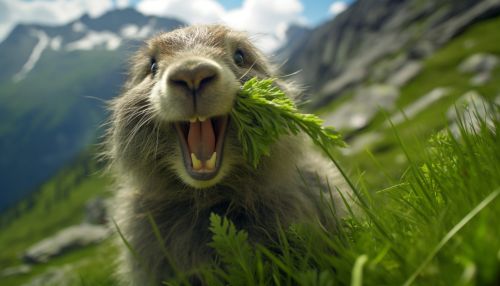Alpine Marmot
Introduction
The Alpine Marmot (Marmota marmota) is a species of marmot found in the high altitudes of the European Alps, Carpathians, Tatras, the Pyrenees and Northern Apennines in Italy. It is characterized by its large body, short legs, and a bushy tail. The Alpine Marmot is a true hibernator and spends more than half of the year in hibernation.


Description
Alpine Marmots are among the largest rodents, with adults typically weighing between 4 and 8 kilograms. They have a robust, cylindrical body, a broad head, and small ears. The fur is dense and woolly, providing insulation against the cold alpine environment. The coloration is a mixture of blonde, reddish and dark gray fur. The belly and undersides are lighter, while the tail and legs are darker.


Habitat and Distribution
Alpine Marmots are found at heights between 800 and 3,200 meters above sea level. They prefer open habitat with loose soil which facilitates burrowing. They are found in alpine meadows, high-altitude pastures, and at the edges of forests. The distribution of the Alpine Marmot has been influenced by human activity, with introductions and reintroductions in various parts of Europe.


Behavior and Ecology
Alpine Marmots are social animals, living in colonies of up to 20 individuals. These colonies are organized around a dominant breeding pair. They are diurnal, active during the day, and spend most of their time foraging for food. In preparation for the winter hibernation, Alpine Marmots can gain up to 1 kilogram of body weight during the summer months.
Diet
The diet of the Alpine Marmot is primarily herbivorous, consisting of grasses, herbs, and occasionally insects and spiders. They have been known to eat a variety of plant material, including flowers, seeds, and roots. During the summer, they spend a large part of the day foraging in order to build up fat reserves for the winter hibernation.


Reproduction
Alpine Marmots mate soon after they emerge from hibernation. The gestation period is around 33-34 days, after which a litter of 2-5 young is born. The young are weaned at around 40 days and reach sexual maturity at 2 years of age. The average lifespan of an Alpine Marmot in the wild is around 15-18 years.
Conservation Status
The Alpine Marmot is not currently considered to be at risk, with a stable population and a wide distribution. However, they are sensitive to changes in their habitat and can be affected by human activities such as agriculture, tourism, and climate change. Conservation efforts are focused on maintaining the quality of their habitat and preventing unnecessary disturbance.
See Also
References
1. Arnold, W. (1990). The evolution of marmot sociality: II. Costs and benefits of joint hibernation. Behavioral Ecology and Sociobiology, 27(3), 239-246. 2. Barash, D. P. (1989). Marmots: social behavior and ecology. Stanford University Press. 3. Blumstein, D. T., & Arnold, W. (1998). Ecology and social behavior of golden marmots (Marmota caudata aurea). Journal of Mammalogy, 79(3), 873-886. 4. Hackländer, K., Arnold, W., & Ruf, T. (2003). Postnatal development and thermoregulation in the alpine marmot (Marmota marmota). Journal of Comparative Physiology B, 173(8), 615-623.
